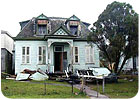Historic Renovation
Built by German immigrant carpenter William Pautch in 1886 in Galveston, Texas, the William Pautch House stood 119 years - surviving even the devastating Galveston Hurricane of 1900 - before falling victim to termite infestation.

Built by German immigrant carpenter William Pautch in 1886 in Galveston, Texas, the William Pautch House stood 119 years - surviving even the devastating Galveston Hurricane of 1900 - before falling victim to termite infestation.
Suffering years of neglect, the historic raised cottage-style home fell off its piling foundation, which stood 8 feet tall, in the spring of 2005. In most American cities, the house would have met a fate similar to an old horse with a broken leg. Each year, hundreds of old homes throughout the country are demolished; their components are dismantled and spread out among landfills and architectural salvage shops.
Folks in Galveston take this sort of occurrence seriously and see it as an opportunity to give new life to a historic treasure. The Galveston Historical Foundation, the second largest local-level, nonprofit historic preservation organization in the United States, stepped in to buy the house and get it back up on its feet.
“We knew it was an important house, and we wanted to save it,” says Brian Davis, director of Preservation Services. “The owner wasn’t able to save it himself, so we bought the house, which is located in Galveston’s Lost Bayou Historic District, and began making plans for its renovation. This house has been around for 120 years, and we want it to make it last another 120.”
Davis researched Galveston insurance records and found a Sanborn Fire Insurance map from the 1890s that described the William Pautch House’s roof as being made from “non-combustible material,” meaning the roof was either metal or slate. Then, he got his answer. While digging holes for the home’s new pilings, Davis found pieces of gray slate shingles. With today’s high prices for slate shingles, Davis sought a high-quality alternative that would provide the traditional look of slate at a more affordable price, while providing the wind load resistance rating required along the Gulf of Mexico.
Having worked in architecture firms for years, Davis was familiar with the quality and styles of CertainTeed shingles, and after browsing the selection, he decided that CertainTeed Grand Manor® Shangle® luxury shingles would be a good fit for the William Pautch House. Not only did the laminated asphalt shingles look like traditional slate, but they were also available in a color - Stonegate Gray - that matched the samples from the home’s original slate roof. The shingles also carry a lifetime warranty, so the longevity of the roof would be guaranteed for the new buyer.
Davis then contacted CertainTeed sales representative Michael Maltbie and got a list of CertainTeed-credentialed roofing contractors in the area. The Galveston Historical Foundation hired Weather Guard Roofing of Houston for the job. Weather Guard Roofing is credentialed as a CertainTeed Select Shingle® Roofer, meaning, among other things, that all management and personnel have passed a course teaching proper installation methods of CertainTeed shingles.

“The shingles were in pretty bad shape and very brittle,” says Don Zienty, owner of Weather Guard Roofing. “And, after the house’s fall, the back portion of the roof was totally gone.”
Weather Guard Roofing began work with a crew of eight to remove the old roof and install 25 squares of Grand Manor Shangle luxury shingles. After the tear-off, the crew laid 25 squares of CertainTeed Roofers’ Select ™ High-Performance Underlayment on the roof deck and CertainTeed WinterGuard™ Waterproofing Underlayment in the valleys before installing the luxury shingles. Though the job posed some difficulties, it also inspired an appreciation among crewmembers for the old-world workmanship that went into the roof’s design, Zienty says.
“We always say they just don’t build things like that anymore,” he says. “Back then, the carpenters were on a totally different level of construction.”
Though included on the list of well-built Victorian-era roof components, the hidden copper gutter system posed a potential problem. During the Victorian period of design, builders would sometimes hide a home’s gutter system by building it into the trim, seeing an exposed gutter system as an eyesore. Though some corrosion and damage to the copper gutters were apparent, Zienty and his crew repaired and restored them without too much trouble or added expense.
“We were relieved we were able to save the copper gutter system,” Zienty says. “If we’d had to do considerable replacement work on it, it would have cost more than the roof itself.”
The roof was finished in three days, a positive first step in restoring the historic home back to its original beauty.
“After we finished, this was, basically, a shell of a building put up on pilings with a great, new roof,” Zienty says. “I think the Grand Manor shingles look fantastic on the house. They work really well with the style of architecture.”
Davis was pleased with the job, and hired Weather Guard Roofing for two more historical preservation reroof jobs, including the Galveston United States Custom House, built in 1861, where the Galveston Historical Foundations has its offices. Davis was pleased with the shingles as well, as they give homeowners and preservationists the ability to emulate historical materials at a more affordable price, he notes.
“Not everyone can afford a slate roof or the maintenance that comes with it,” he says. “I have been very pleased with the quality, the color selection and the look of the CertainTeed luxury shingle line. The Grand Manor luxury shingles make the William Pautch House look so much more impressive. The house is really getting back to the way it originally looked.”
The home continues to make progress since the completion of the roofing job last year. There is a new staircase leading up to the front door and the aged asbestos siding has been removed. The house will now display its original sideboards, restored and repainted.
The Galveston Historical Foundation preservation projects operate on a revolving fund. The organization has saved 35 Galveston-area historic commercial buildings and 40 historic homes since its preservation program began in 1972.
For more information, call 800-233-8990, e-mail buildingsolutions@saint-gobain.com or visit www.certainteed.com.

Built by German immigrant carpenter William Pautch in 1886 in Galveston, Texas, the William Pautch House stood 119 years - surviving even the devastating Galveston Hurricane of 1900 - before falling victim to termite infestation.
Suffering years of neglect, the historic raised cottage-style home fell off its piling foundation, which stood 8 feet tall, in the spring of 2005. In most American cities, the house would have met a fate similar to an old horse with a broken leg. Each year, hundreds of old homes throughout the country are demolished; their components are dismantled and spread out among landfills and architectural salvage shops.
Folks in Galveston take this sort of occurrence seriously and see it as an opportunity to give new life to a historic treasure. The Galveston Historical Foundation, the second largest local-level, nonprofit historic preservation organization in the United States, stepped in to buy the house and get it back up on its feet.
“We knew it was an important house, and we wanted to save it,” says Brian Davis, director of Preservation Services. “The owner wasn’t able to save it himself, so we bought the house, which is located in Galveston’s Lost Bayou Historic District, and began making plans for its renovation. This house has been around for 120 years, and we want it to make it last another 120.”
Roofing Takes Top Priority
To ensure the interior’s protection from the elements, Davis knew it would be vital to focus first on the home’s roof. The old asbestos diamond-pattern shingles had deteriorated, and a later addition on the back of the home, where the termites had concentrated, was badly damaged from the fall. The next step was to do research on the original roof and find a suitable replacement roofing material.Davis researched Galveston insurance records and found a Sanborn Fire Insurance map from the 1890s that described the William Pautch House’s roof as being made from “non-combustible material,” meaning the roof was either metal or slate. Then, he got his answer. While digging holes for the home’s new pilings, Davis found pieces of gray slate shingles. With today’s high prices for slate shingles, Davis sought a high-quality alternative that would provide the traditional look of slate at a more affordable price, while providing the wind load resistance rating required along the Gulf of Mexico.
Having worked in architecture firms for years, Davis was familiar with the quality and styles of CertainTeed shingles, and after browsing the selection, he decided that CertainTeed Grand Manor® Shangle® luxury shingles would be a good fit for the William Pautch House. Not only did the laminated asphalt shingles look like traditional slate, but they were also available in a color - Stonegate Gray - that matched the samples from the home’s original slate roof. The shingles also carry a lifetime warranty, so the longevity of the roof would be guaranteed for the new buyer.
Davis then contacted CertainTeed sales representative Michael Maltbie and got a list of CertainTeed-credentialed roofing contractors in the area. The Galveston Historical Foundation hired Weather Guard Roofing of Houston for the job. Weather Guard Roofing is credentialed as a CertainTeed Select Shingle® Roofer, meaning, among other things, that all management and personnel have passed a course teaching proper installation methods of CertainTeed shingles.

When the Galveston Historical Foundation took over the restoration process, the cottage had fallen off of its piling foundation and a section of the roof had been destroyed.
A Challenging Project
Though the cottage has a small roof, it still posed some logistical challenges, stemming from the Victorian-era design of the home. The roof’s pitch ranged from 3:12 at its lowest to more than 12:12 at its steepest. The house also had an arched doorway, two eyebrow dormers in front and two side dormers. And then, there were the timeworn asbestos shingles.“The shingles were in pretty bad shape and very brittle,” says Don Zienty, owner of Weather Guard Roofing. “And, after the house’s fall, the back portion of the roof was totally gone.”
Weather Guard Roofing began work with a crew of eight to remove the old roof and install 25 squares of Grand Manor Shangle luxury shingles. After the tear-off, the crew laid 25 squares of CertainTeed Roofers’ Select ™ High-Performance Underlayment on the roof deck and CertainTeed WinterGuard™ Waterproofing Underlayment in the valleys before installing the luxury shingles. Though the job posed some difficulties, it also inspired an appreciation among crewmembers for the old-world workmanship that went into the roof’s design, Zienty says.
“We always say they just don’t build things like that anymore,” he says. “Back then, the carpenters were on a totally different level of construction.”
Though included on the list of well-built Victorian-era roof components, the hidden copper gutter system posed a potential problem. During the Victorian period of design, builders would sometimes hide a home’s gutter system by building it into the trim, seeing an exposed gutter system as an eyesore. Though some corrosion and damage to the copper gutters were apparent, Zienty and his crew repaired and restored them without too much trouble or added expense.
“We were relieved we were able to save the copper gutter system,” Zienty says. “If we’d had to do considerable replacement work on it, it would have cost more than the roof itself.”
The roof was finished in three days, a positive first step in restoring the historic home back to its original beauty.
“After we finished, this was, basically, a shell of a building put up on pilings with a great, new roof,” Zienty says. “I think the Grand Manor shingles look fantastic on the house. They work really well with the style of architecture.”
Davis was pleased with the job, and hired Weather Guard Roofing for two more historical preservation reroof jobs, including the Galveston United States Custom House, built in 1861, where the Galveston Historical Foundations has its offices. Davis was pleased with the shingles as well, as they give homeowners and preservationists the ability to emulate historical materials at a more affordable price, he notes.
“Not everyone can afford a slate roof or the maintenance that comes with it,” he says. “I have been very pleased with the quality, the color selection and the look of the CertainTeed luxury shingle line. The Grand Manor luxury shingles make the William Pautch House look so much more impressive. The house is really getting back to the way it originally looked.”
The home continues to make progress since the completion of the roofing job last year. There is a new staircase leading up to the front door and the aged asbestos siding has been removed. The house will now display its original sideboards, restored and repainted.
The Galveston Historical Foundation preservation projects operate on a revolving fund. The organization has saved 35 Galveston-area historic commercial buildings and 40 historic homes since its preservation program began in 1972.
For more information, call 800-233-8990, e-mail buildingsolutions@saint-gobain.com or visit www.certainteed.com.
Looking for a reprint of this article?
From high-res PDFs to custom plaques, order your copy today!




